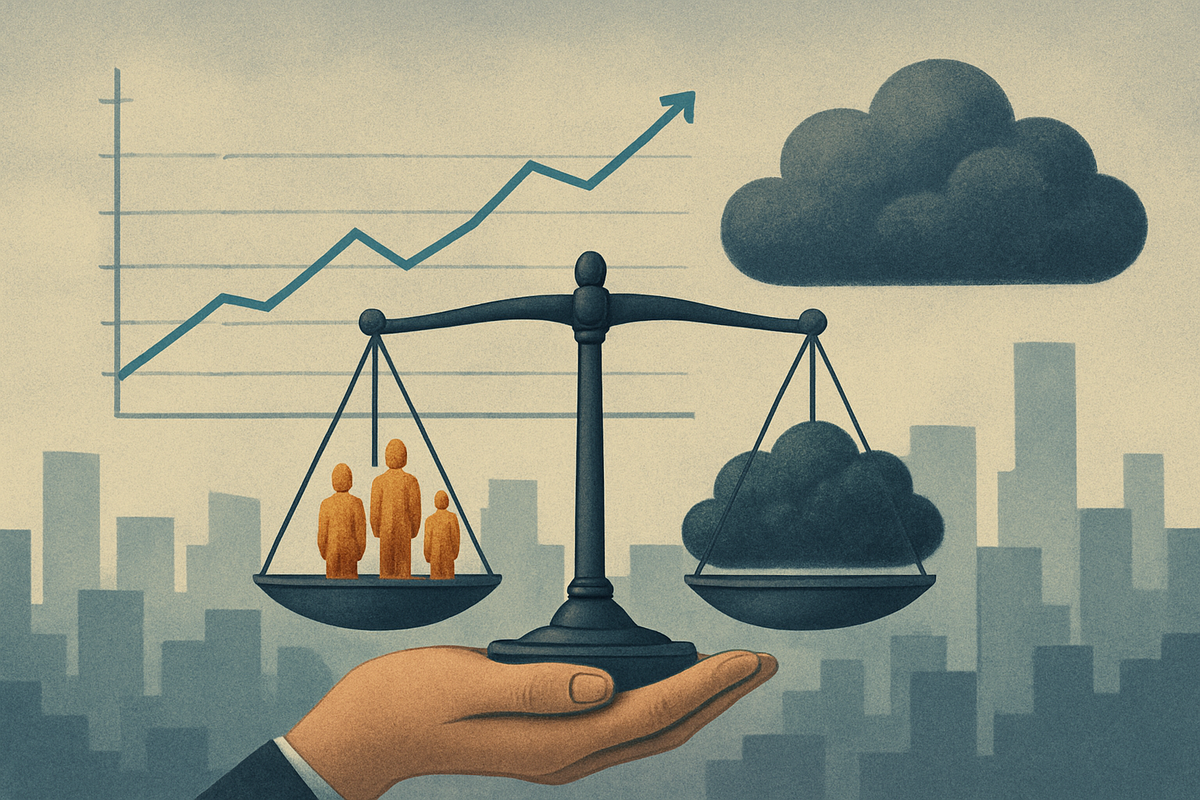
The latest ADP National Employment Report for October 2025, released on November 5, 2025, delivered a mixed bag for financial markets, revealing a modest increase of 42,000 private sector jobs. While this figure technically surpassed economist expectations and marked a rebound after two consecutive months of declines, deeper analysis of the data suggests a labor market still grappling with underlying weaknesses. This nuanced picture presents a significant challenge for the Federal Reserve's monetary policy decisions and could temper investor sentiment, particularly given the ongoing U.S. government shutdown that has delayed official labor market statistics from the Bureau of Labor Statistics (BLS).
The health of the labor market is a cornerstone of economic stability and a critical barometer for investor confidence. A robust job market typically signals strong consumer spending and corporate profitability, fostering optimism and driving stock market performance. Conversely, signs of a weakening labor market, such as slowing job creation or rising unemployment, often foreshadow an economic slowdown, leading to decreased consumer demand and lower corporate earnings, which can exert downward pressure on equity valuations. The current ADP data, with its "tepid" and "not broad-based" growth, despite exceeding headline expectations, offers a complex narrative that investors are now dissecting for clues about the economy's trajectory and the Federal Reserve's next move.
Nuanced Growth in October's Employment Landscape
The October 2025 ADP National Employment Report, compiled by ADP (NASDAQ: ADP) in collaboration with the Stanford Digital Economy Lab, reported a gain of 42,000 private sector jobs. This figure stood notably above the consensus forecasts from economists, who had largely anticipated a more modest increase ranging between 22,000 and 32,000 new private sector jobs. The report's release on November 5, 2025, carried amplified importance due to an ongoing U.S. government shutdown, which had postponed the customary release of official labor market data from the BLS, making the ADP report one of the few timely indicators available to gauge the nation's employment health.
Despite the headline beat, the specifics of the report painted a less robust picture. The job gains were far from broad-based, primarily concentrated in the education and health care sectors, and trade, transportation, and utilities. In contrast, several key sectors continued to shed jobs for the third consecutive month, including professional business services, information, and leisure and hospitality. Furthermore, the report highlighted a significant divergence in hiring patterns: large companies were the primary drivers of the increase in payrolls, while small businesses experienced a decline in employment for the fifth time in six months, signaling strain among smaller enterprises.
Adding to the cautious interpretation, weekly data embedded within the report indicated a slowdown in the latter half of October. Private employers reportedly cut an average of 11,250 jobs per week in the four weeks ending October 25, suggesting that the labor market struggled to consistently create jobs throughout the month. Nela Richardson, ADP's chief economist, characterized the October bounce in hiring as "tepid" and "not broad-based," underscoring concerns that overall job growth may remain slow due to a combination of reduced demand and a constrained supply of workers. Annual pay growth also remained flat compared to the previous month, with "job-stayers" seeing a 4.5% increase and "job-changers" a higher 6.7%, a trend that has held steady for over a year, indicating a balanced but not accelerating wage environment.
Initial market reactions to the ADP report were complex. While a stronger-than-expected headline job number might typically spark optimism, the underlying details tempered enthusiasm. The report's release came shortly after the Federal Reserve's decision on October 29th to implement an interest rate cut, aimed at stimulating economic activity. The unexpected job growth, even if "tepid," introduced a layer of complexity for future monetary policy, as it could signal persistent inflationary pressures that might challenge the rationale for further rate reductions. This created uncertainty among investors, leading to cautious trading as they weighed the implications for the Federal Open Market Committee's (FOMC) future stance.
Companies Navigating a Shifting Employment Landscape
A weakening, albeit subtly, labor market presents a mixed bag for public companies, creating both potential winners and losers depending on their sector, operational structure, and sensitivity to economic cycles. Companies heavily reliant on robust consumer spending or those with high labor costs are particularly vulnerable to a slowdown in job creation and wage growth. Conversely, some sectors might find opportunities in a less competitive labor market or benefit from potential shifts in monetary policy.
In a climate of "tepid" job growth and declining small business employment, consumer discretionary companies could face headwinds. Businesses like Target (NYSE: TGT), Amazon (NASDAQ: AMZN), and Starbucks (NASDAQ: SBUX), which thrive on strong consumer confidence and disposable income, might see reduced sales volumes as households become more cautious with their spending. Similarly, the leisure and hospitality sector, which has already experienced job losses according to the ADP report, could continue to struggle. Hotel chains like Marriott International (NASDAQ: MAR) and cruise operators such as Carnival Corporation (NYSE: CCL) may face diminished demand if unemployment ticks up or wage growth stagnates.
Conversely, companies in staffing and recruitment, such as Robert Half International (NYSE: RHI) or ManpowerGroup (NYSE: MAN), could face increased demand for their services as businesses seek more flexible workforce solutions or look to optimize costs in an uncertain environment. However, a prolonged slowdown could eventually reduce overall hiring volumes, impacting even these firms. Furthermore, sectors that benefit from lower interest rates, should the Federal Reserve decide to ease policy further in response to a weakening economy, could see a boost. Real estate investment trusts (REITs) like Prologis (NYSE: PLOG) or utilities companies such as NextEra Energy (NYSE: NEE), which often rely on debt financing, might benefit from reduced borrowing costs.
Technology companies, particularly those in professional business services and information sectors which saw job losses, might be undergoing restructuring or cost-cutting measures. While some tech giants like Microsoft (NASDAQ: MSFT) or Google's parent Alphabet (NASDAQ: GOOGL) have diverse revenue streams that offer some resilience, smaller, more growth-oriented tech firms could face pressure if business spending tightens. Additionally, companies providing essential services or value-oriented products, such as Walmart (NYSE: WMT) or Costco Wholesale (NASDAQ: COST), might prove more resilient as consumers prioritize necessities over discretionary purchases during economic uncertainty.
Broader Economic Implications and Historical Context
The nuanced signals from the October ADP report fit into a broader narrative of economic recalibration following a period of post-pandemic recovery and elevated inflation. The Federal Reserve has been actively managing monetary policy to achieve a "soft landing" – cooling inflation without triggering a severe recession. The "tepid" job growth, particularly the decline in small business employment and job losses in certain sectors, suggests that the Fed's efforts to temper demand are having an effect, albeit unevenly. This event highlights the delicate balance policymakers must strike: too much tightening risks a deeper economic downturn, while insufficient action could allow inflationary pressures to persist.
The ripple effects of a weakening labor market extend beyond direct employment figures. Reduced consumer spending power, a likely outcome of slower job growth and stagnant wages, can impact a wide array of industries. Retailers, manufacturers, and service providers could experience decreased demand, leading to lower revenues and potentially further job cuts, creating a self-reinforcing cycle. On the regulatory and policy front, a persistently weak labor market might increase pressure on the government to implement fiscal stimulus measures or unemployment support programs, particularly with the ongoing government shutdown adding another layer of economic uncertainty.
Historically, periods of slowing job growth have often preceded broader economic downturns or recessions. Comparing the current situation to previous cycles, such as the lead-up to the 2008 financial crisis or even more modest slowdowns, provides valuable context. For instance, the dot-com bubble burst in the early 2000s saw a significant contraction in the information technology sector, similar to the current job losses in the information sector noted by ADP. However, each economic cycle has unique characteristics. The current environment is marked by persistent supply chain issues, geopolitical tensions, and a complex inflation dynamic that differentiates it from past downturns, making direct comparisons challenging but still useful for understanding potential trajectories.
The Federal Reserve's actions remain a critical factor. The rate cut on October 29th indicated a leaning towards easing monetary conditions, but the stronger-than-expected ADP headline figure, even with its underlying weaknesses, could complicate future decisions. If the Fed perceives that the labor market, despite some softness, is not weakening fast enough to curb inflation, it might pause further rate cuts or even consider a hawkish pivot. Conversely, if subsequent data confirm a more significant slowdown, it could accelerate the path to further easing, aiming to prevent a deeper recession. This creates a policy tightrope walk with significant implications for market stability and economic growth.
The Path Ahead: Navigating Uncertainty
Looking ahead, the immediate future for the stock market and the broader economy will largely hinge on the trajectory of the labor market and the Federal Reserve's response. In the short term, investors will be closely watching for the resolution of the U.S. government shutdown, which is delaying crucial official economic data. The release of the full BLS jobs report, once available, will provide a more comprehensive picture and could either corroborate or contradict the ADP's findings, potentially triggering significant market movements. Until then, volatility is likely to persist as market participants operate with incomplete information.
In the long term, the economy faces several potential scenarios. One possibility is a "soft landing," where the labor market gradually cools, inflation recedes to the Fed's target, and a recession is averted. In this scenario, corporate earnings could stabilize, and the stock market might resume a steady upward trend. However, a less optimistic outcome involves a more pronounced economic slowdown or even a recession, triggered by persistent labor market weakness, high interest rates, or external shocks. Such a scenario would likely lead to further corporate earnings contractions and a more significant market correction.
Companies will need to adapt strategically to this evolving environment. Those heavily exposed to consumer discretionary spending may need to focus on cost efficiencies, inventory management, and potentially diversify their product offerings to cater to more value-conscious consumers. Technology and professional services firms, which have seen job losses, might continue to rationalize their workforces and invest in automation to maintain profitability. Companies with strong balance sheets and diversified revenue streams will be better positioned to weather any economic storms and potentially acquire distressed assets or competitors.
Market opportunities could emerge for investors in defensive sectors such as utilities, consumer staples, and healthcare, which tend to be more resilient during economic downturns. Additionally, companies with innovative technologies that enhance productivity or reduce costs could see increased demand as businesses seek efficiencies. Conversely, challenges will include navigating potential earnings downgrades, increased credit risk for some businesses, and the ongoing uncertainty surrounding interest rate policy. Investors should prepare for continued market choppiness and focus on companies with strong fundamentals, sustainable business models, and proven resilience.
A Delicate Balance: Assessing Market Significance and Future Outlook
The October ADP National Employment Report serves as a crucial, albeit incomplete, snapshot of a labor market at a pivotal juncture. While the headline job creation figure offered a glimmer of hope by exceeding expectations, the underlying details — including tepid, non-broad-based growth, declining small business employment, and continued job losses in key sectors — paint a more cautious picture of an economy where the labor market is subtly but surely weakening. This delicate balance creates a complex environment for investors and presents a significant challenge for the Federal Reserve as it navigates its dual mandate of price stability and maximum employment.
Moving forward, the market's trajectory will be heavily influenced by how these labor market dynamics evolve and how the Federal Reserve interprets them. If the labor market continues to show signs of softening, it could provide the Fed with more room to ease monetary policy, potentially stimulating economic activity and supporting asset prices. However, if inflation remains stubbornly high despite this softening, the Fed could find itself in a difficult position, forced to maintain higher rates for longer, which would likely prolong economic uncertainty and weigh on market performance.
For investors, the key takeaway is the heightened need for vigilance and a discerning eye. The era of easy gains driven by a uniformly strong labor market may be giving way to a more selective environment. Investors should carefully monitor subsequent economic data, particularly when the official BLS reports become available, as well as the Federal Reserve's communications for clues on future monetary policy. Focusing on companies with robust financial health, adaptability to changing economic conditions, and clear competitive advantages will be paramount in the coming months. The market is not out of the woods, and understanding the nuances of the labor market will be critical to successful investing in this uncertain period.
This content is intended for informational purposes only and is not financial advice







